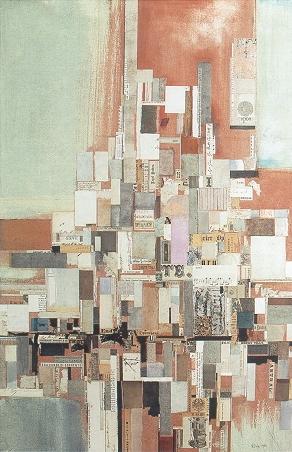
William Dole
American, 1917-1983
Tower of Babel, 1962
watercolor and collage on board
35 x 23 in.
SBMA, Gift of Dean Valentine and Amy Adelson, Los Angeles
2005.9
COMMENTS
William Dole was a significant artist who turned from Abstract Expressionism to create a new visual vocabulary in his collage work. Using appropriated typographic elements and other mixed media, Dole's work bridged the Dada tradition of collage to the theories and compositional practices of Abstract Expressionism.
William Dole was born in 1917 in Angola, Indiana to his postmaster father, W. Earl Dole and his mother, Edna Cowen Dole. Throughout his adolescence, Dole was enthralled by the reproductions of artworks embedded in the pages of women’s magazines such as the Ladies’ Home Journal and Vanity Fair. From highschool he was offered scholarships to the John Herron Art School and Olivet College. Dole chose to further his education at Olivet and studied English Literature. He also apprenticed under George Rickey, receiving a degree in Art History and went on to receive his teaching credentials in art. It was during the 1940s that Dole enrolled in art classes at Mills College in Oakland, California were he met and married his wife, Kate Holcomb Dole in 1941. Soon after his marriage to Kate, Dole was enlisted in the army where he was given a position teaching art to fellow cadets.
With three children and an end to his war duties, Dole attempted a job as a commercial artist for Virgil A. Advertising. He quickly changed his mind when he entered graduate school at the University of California, Berkeley in the summer of 1946. It was here that he continued on for two years as a lecturer in the Arts Department. During these years Dole began professionally exhibiting his work. In 1949, he took on a position as an Assistant Professor at the University of California, Santa Barbara. In 1955 he took sabbatical from the college in order to take his family to Florence, Italy for two years. Enthused by a leather journal filled with scraps of paper, Dole diverged on his path of watercolors and began creating collages inspired by Italian landscapes.
Returning to the United States, the artist was appointed Department Chairman in 1958 and went on to become a full time professor in 1962. Collage quickly became his medium and developed interest in the work of George Braque, Kurt Schwitters (1887- 1948) and Joseph Cornell (1903-1972). Throughout the 1950s, Dole’s exhibited in Berlin, Mexico City, Rome, and London. At this time, Dole was appointed Department Chairman in 1971 until 1974. The “William Dole Retrospective 1960-1975” Exhibition traveled from 1976 from the Los Angeles Municipal Art Gallery to the Santa Barbara Museum of Art. Dole was also awarded with an honorary degree as a Doctor of Fine Arts by Olivet College in 1978 and continued working till his death in Santa Barbara in the year 1983.
II. AN ANALYSIS OF THE ARTIST’S WORK
As a child, Dole was enthralled by European oil paintings at the World Fair, and it these early observation that inspirsed Dole to pursue the arts. He is well-known for his oeuvre of oils, drawings, water colors, prints, and his infamous works in collage. The artist began his career under a Social Realist influence working as an apprentice under George Rickey in 1937-38 and later as an art teacher for the US Army. Dole’s return to graduate school lead him to teach a variety of art classes at both the University of California Berkeley as well as Santa Barbara, leaving little time to paint. When he did find time, Dole consistently sketched his surroundings. As curator Paul Mills noted Dole’s art was a “product of his looking”. Whether it was his children playing, the fields around his Santa Ynez home, or the papers on his desk, Dole’s works transformed into personal examinations of the world he was experiencing.
During his time in Florence, Dole’s watercolors and drawings were heavily influenced by the new and unfamiliar landscapes. Dole created faux settings by piecing disparate elements of these landscapes together which turned him to experiment with collage. It wasn’t until his return from Italy around 1958 that Dole converted his main medium to collage.
He was quick to abandon his representational use of collage for something less referential. Intrigued by a collection of Japanese papers and an Italian leather journal full of book pages, letters, maps, and more, Dole began to produce what many refer to as “magical” and seemingly “poetic” visual entities. His use of commonplace elements shapes, colors, and letters become unfamiliar as they are arranged to recreate the known world for the viewer. The artist’s inspiration often derived from the visual environment by which he was surrounded. One series titled Memos reflects the visual landscape such as letterheads and work documents from his office in the Art Department.
Dole’s passion for collage did not stem from the influence of one particular artist but his passion and intrigue for materials. The texture of certain papers, the shape of a Chinese character, the geometric quality of scientific diagrams, inspired Dole to combine these fragments onto one canvas. His goal was not for the viewer to derive a particular meaning but to view the collage as a new visual experience. The artist comments on the respect he holds for the written word that goes beyond its meaning when he states,
“I believe that if you place a letter or a word or a group of words in a composition, you create a kind of visual energy that is different from an intense color…I sometimes use words in this way to create an area of interest or to create a kind of texture that has visual weight that a purely abstract texture wouldn’t have. Being able to create this kind of visual effect is almost like adding another primary color to your palette”.
by Kelly Brent
Sullivan Goss
AN AMERICAN GALLERY
